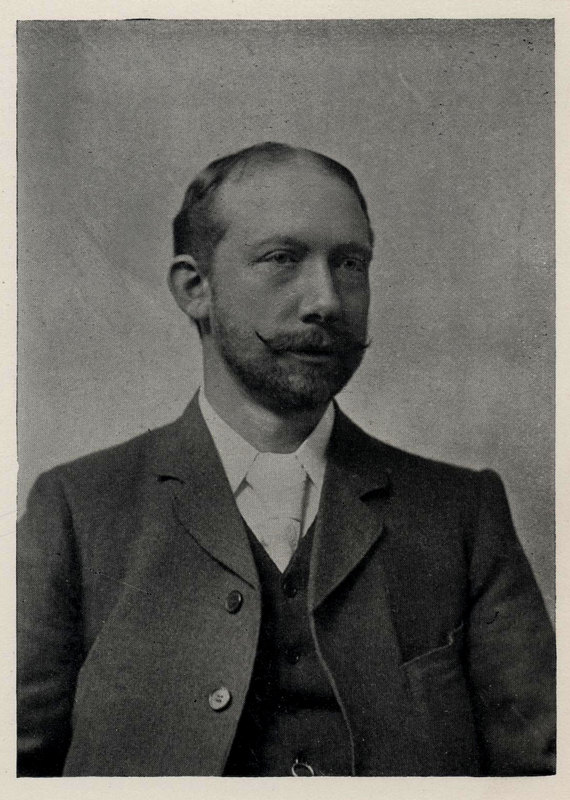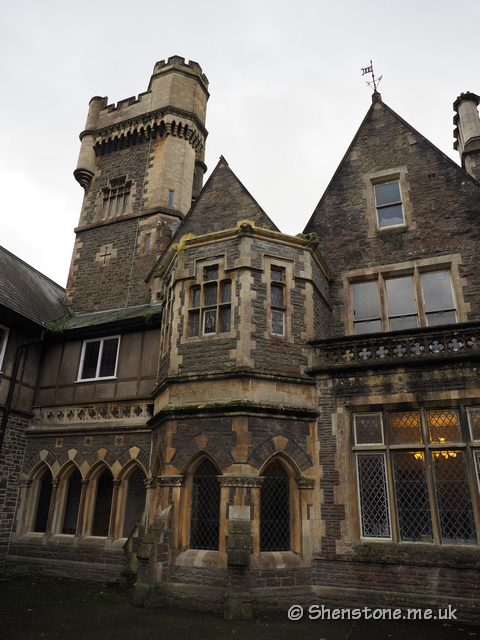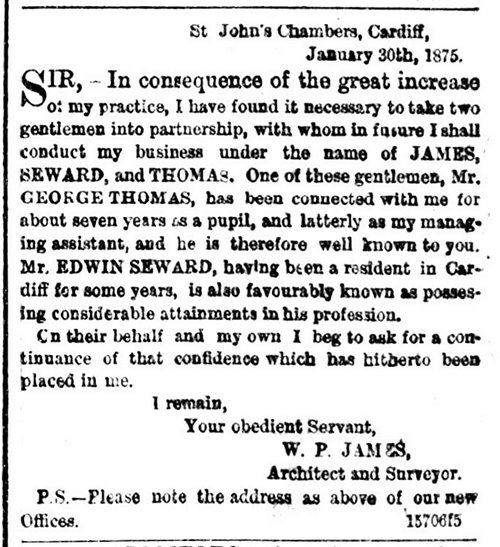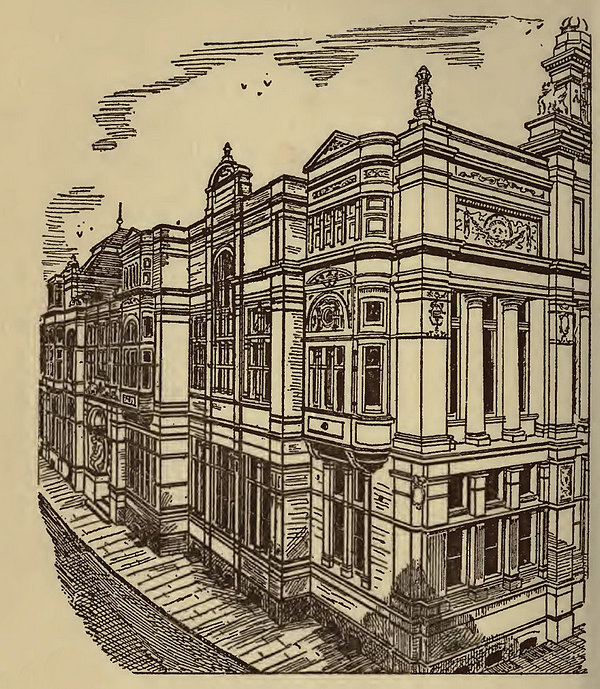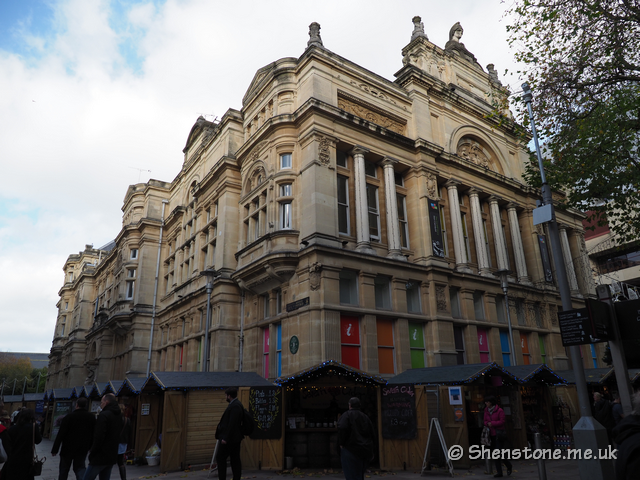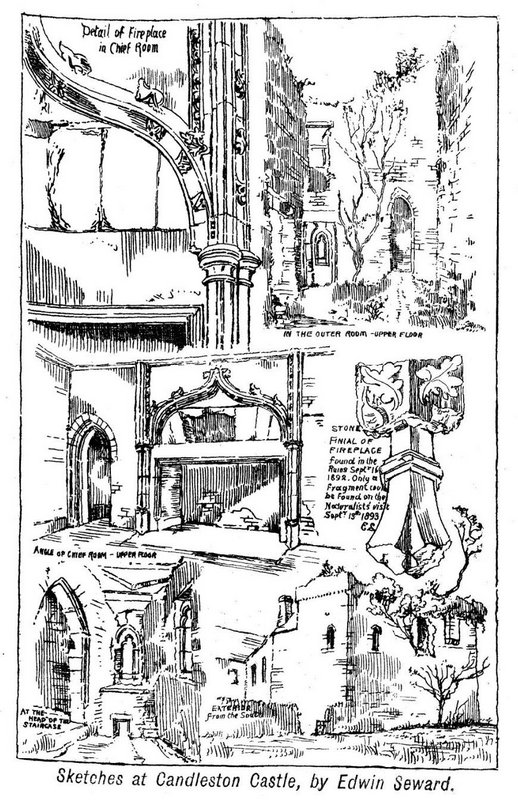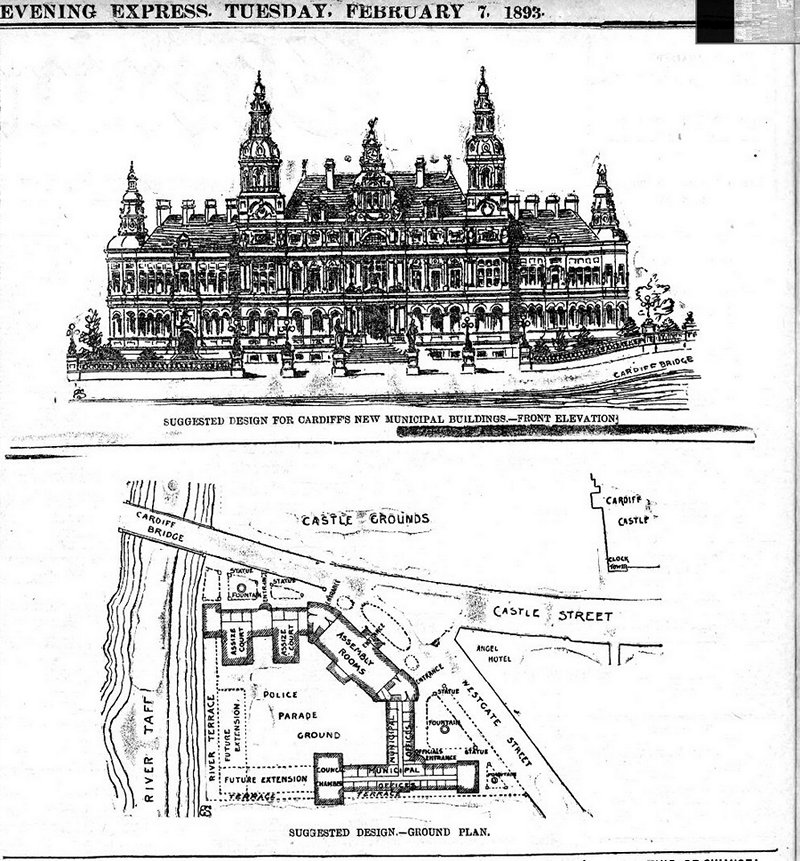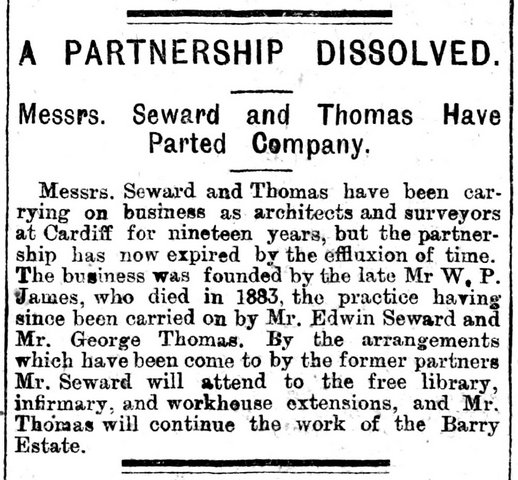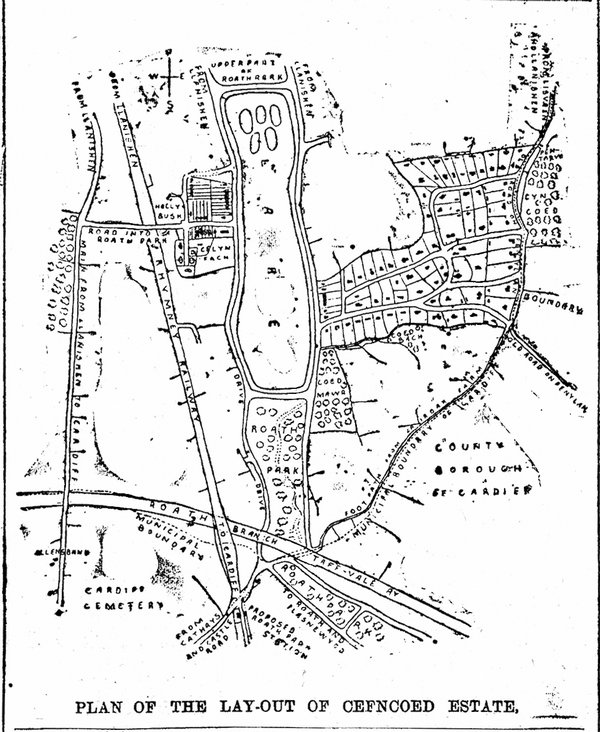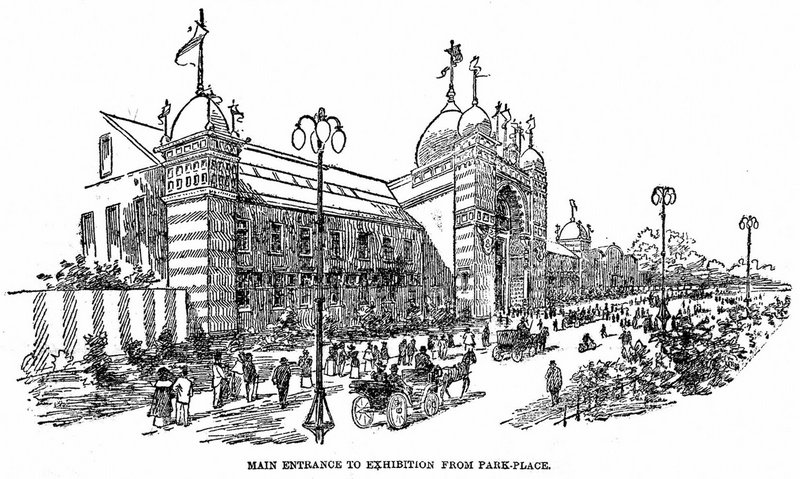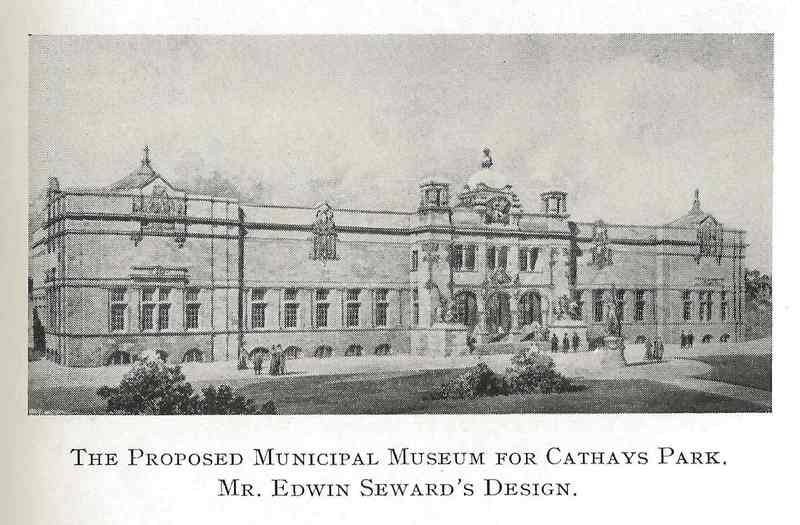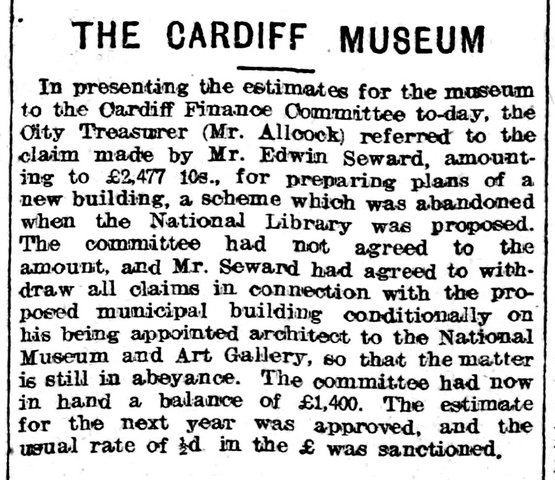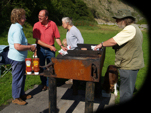
Cardiff
Naturalists' Society
Cymdeithas Naturiaethwyr
Caerdydd
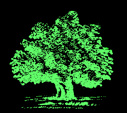
Edwin Seward, F.R.I.B.A. (1853–1924) 21st President
|
Back to the 150th Anniversary index Born in Yeovil in Somerset, Seward came to Cardiff in his sixteenth year as an assistant to George Robinson 10th President whom in many ways he was to outstrip in terms of buildings in Cardiff. Edwin Seward from Contemporary Portraits. Men and women of South Wales and Monmouthshire. Cardiff Section, Western Mail Ltd. 1896 One of his first works involved extending Insole Court, Llandaff, he then went on to design many important buildings in Cardiff Key amongst these are buildings which are well documented elsewhere: -
Insole Court, aspects developed by Robinson and Seward Insole Court, aspects developed by Robinson and Seward As noted above, in 1875 he moved into partnership with W P James and George Thomas. It is noteworthy that there is another Cardiff Naturalists' Society link here in that William Parry James was the brother-in-law of Peter Price the 12thPresident with whom James had been in partnership until 1867 Partnership Announcement The Western Mail 2nd February 1875 Old Library West side from Ballinger 1895 Old Library West side in 2017 he gave an extensive presidential address covering many aspects of the Societies aims and interests which was printed in Volume XXV of the transactions in 1893 and is available at the NLW Journals site. In the same edition of the transactions there is an excellent drawing of architectural features of Candleston Castle Sketches made by Edwin Seward at Candleston Castle in Volume XXV of the Transactions His interest in and accomplishments in Art are well documented and in 1884 he worked with T.H. Thomas 16th President on a Fine Art Exhibition At Cardiff. From many references it is clear that the two men had a close working relationship on a number of important projects for Cardiff. Fine Art Exhibition At Cardiff Weekly Mail 23rd February 1884 For the Municipal Museum, Mr. Edwin Seward was appointed architect. His plans were apparently ready when it became known that a National Museum of Wales was to be brought into being. His scheme was therefore held up, eventually abandoned, and subsequently provided the subject of an action at law After is presidency he remained an active member for many years and in Vol XL of the transactions it is noted under Field Days that on Sept. 25, 1907. A visit was paid to the "Castell" field at Craig Llwyn, Lisvane, to inspect the mounds and other evidences of early occupation. Mr. Edwin Seward, F.R.I.B.A., read a short descriptive paper, and afterwards Mr. and Mrs. Seward entertained the party to tea at Lisvane House. Lisvane House, became a listed building in 2000 it was listed for its Arts and Craft style and 1688 staircase. Unfortunately the staircase was removed when the house was converted into 6 flats. However his relationship with the society was ultimately to end and the reasons are possibly in relation to his many other works and ideas for the borough of Cardiff as it was then. Many of his ideas, proposals, successes and ultimately disappointments and disputes are well documented in local papers. As early as 1893 he was making one of many proposals for Municipal buildings in Cardiff Municipal buildings suggested design by Mr. Edwin Seward Evening Express 7th February 1893 In 1894 his partnership with George Thomas was dissolved (W.P. James having passed away earlier) A Partnership Dissolved. Evening Express 9th January 1894 Seward was very busy as in the same year it is reported that he was responsible for the layout of the Cefncoed (now known as Cyncoed) developments to the east of Roath park lake Roath Park opening. South Wales Echo 12th June 1894 Plan Of The Lay-Out Of Cefncoed Estate, Development Of The District. Evening Express 1st August 1894 it was further noted to another design in 1895 that "His design for a new Town-hall at the north-end of Cardiff Arms. Park was a very noble one, and, if it could have been carried out, would have given us such a hall with such surroundings as would have been the envy of nearly every provincial town in the kingdom" Municipal buildings suggested design by Evening Express 14th October 1895 These were not realised, but he did go on to design and oversee the construction of a major building which is not listed above because it was a temporary building. It was a truly impressive sight as documented in this from the South Wales Echo 4th May 1896
Main entrance to the Exhibition from Park Place South Wales Echo 4th May 1896 By 1905 he had been successful in gaining the commission to design the new Cardiff Museum to be located in Cathays Park. Cardiff Museum Seward design. Volume LXV of the Transactions However by 1908 it was clear that his plans were not moving forwards and the court of governors of the new National Museum of Wales had decided to put it to open competition and selected in due course the design by the firm of Smith and Dunbar. Seward claimed damages from the Corporation Cardiff Museum. Evening Express 10th March 1908 the case was still ongoing in 1910 and there are detailed reports in the local newspapers of the proceedings and the various witness statements. (I have not yet tracked down the result of this case. if anyone reading this knows the result please get in contact with the publicity officer via the contacts page). However this should not be something that overshadows the many positive things that Seward did for Cardiff an example of which is his campaigning for better fire safety To Save The Children, Evening Express 9th January 1909 The last 2 references I can find (online I have not done a careful physical search) regarding him in local newspapers indicate that the rift may have been large enough for him to want to distance himself from institutions that he had once been closely involved with are this... from the Barry Dock News 14th January 1916...
And this from the Llanelly Star 26th May 1917...
So we know he moved away at some point between those dates. He lived there until 1924. His final distance from the area along with the acrimonious dealings with some other key members of the society (such are reported in the South Wales Daily News 23rd February 1895 in relation to the original Cardiff Museum design) probably explains the lack of a detailed obituary in the Transactions for such a distinguished ex-president Some other internet links relating to Seward Back to the 150th Anniversary index Before this... Charles Thomas Whitmell (1849 – 1919) 20th President Next up... Robert William Atkinson, B.Sc. (Lond.), F.I.C., F.C.S. 22nd and 54th President See our Full list of Presidents These pages are part of the Cardiff Naturalists' Society 150th Anniversary celebrations and are about our history and are celebrating the people who developed our Society and helped build the city and the cultural heritage of Cardiff. You can read more about that using the links above If you want to read about the ways we study the wildlife and environment of the Cardiff area and its surroundings, and about the talks we have about the wildlife of the world, and find the programme of talks, walks and other events that we do then please take a look at our main website, our blog and our facebook and twitter feeds for up to date news |
